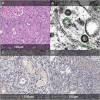Case Report: SARS-CoV-2 Associated Acute Interstitial Nephritis in an Adolescent
- PMID: 35498789
- PMCID: PMC9047909
- DOI: 10.3389/fped.2022.861539
Case Report: SARS-CoV-2 Associated Acute Interstitial Nephritis in an Adolescent
Abstract
Acute interstitial nephritis (AIN) has been recently recognized as one of the infrequent kidney involvement phenotypes among adult patients with severe acute respiratory syndrome coronavirus 2 (SARS-CoV-2) infection. Although SARS-CoV-2 associated intrinsic kidney disease has been scarcely reported in children, only one case of AIN temporally associated with the infection has been described in the pediatric population so far. We presented a case of a 12-year old boy who presented with fatigue, anorexia, and polydipsia following an RT-PCR that confirmed SARS-CoV-2 infection seven weeks prior to admission. Initial workup revealed increased serum creatinine (235 μmol/L), glucosuria, low-molecular-weight proteinuria, mild leukocyturia, and microhematuria with hyaline and granular casts on microscopy. Antibodies against the SARS-CoV-2 S protein receptor-binding domain confirmed prior infection with high titers. Kidney biopsy showed diffuse active interstitial nephritis with negative immunofluorescence and positive immunohistochemistry for SARS-CoV-2 in the inflammatory cells within the interstitium. Electron microscopy revealed several SARS-CoV-2-like particles. Kidney function continued to deteriorate despite several days of supportive therapy only (peak serum creatinine 272 μmol/L); thus, treatment with methylprednisolone pulse-dose therapy was initiated and was followed by oral prednisolone with gradual tapering. Kidney function completely recovered after 3 weeks post-discharge and remained normal after 11 weeks of follow-up (last estimated glomerular filtration rate 106 ml/min/1.73 m2) with only residual microhematuria. Our case adds to the emerging evidence of SARS-CoV-2 as a potential etiological agent of AIN in children and also suggests that interstitial kidney injury may result from secondary inflammatory damage. Epidemiological history, serologic testing, and SARS-CoV-2 detection in biopsy should be considered in the work-up of children with AIN of unknown etiology.
Keywords: COVID-19; SARS-CoV-2; acute interstitial nephritis; children; coronavirus; pediatric.
Copyright © 2022 Azukaitis, Besusparis, Laurinavicius and Jankauskiene.
Conflict of interest statement
The authors declare that the research was conducted in the absence of any commercial or financial relationships that could be construed as a potential conflict of interest.
Figures


References
Publication types
LinkOut - more resources
Full Text Sources
Miscellaneous

